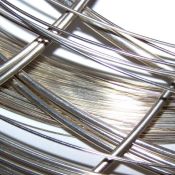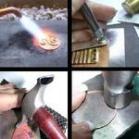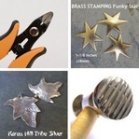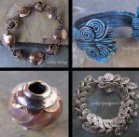▪ What Size Wire Is That? ▪

An often asked question for new wire workers is, What size gauge wire do I need to use? Wire is sized in gauges. Completely opposite of what you would think, the smaller the gauge number the greater the diameter of the wire. Below, Ive listed some of the most commonly used gauges - in metric and standard - and their uses. The lengths per ounce are for Sterling silver.
Important Note: Most tools have a limit to the wire size they can be used with. Some tools are very expensive, so be sure to check the wire size limitations of your tools so that you can eliminate damaging your tools and enjoy using them for many years.
In addition to saving your tools, you'll find that using the right tools will make the job easier and more comfortable on your hands. I use pliers better suited for fine wire when working with 26 and 30 gauge wires, and I have other pliers and cutters for heavier work. Yup, the old adage is true....one can never have too many tools!
12 gauge
Approx. 0.081 inches (2.00mm) in diameter ~ 2' ll-2/3" per ounce ~ For Sterling silver, this is a very heavy wire, great for using as the core of a bangle bracelet. Special heavy wire tools are needed to manipulate this wire.
14 gauge
Approx. 0.064 inches (1.6mm) in diameter ~ 4' 9" per ounce ~ This wire is commonly used for bangle bracelets, both with one core or multi-sectioned. It makes great large, very strong jumprings. Perfect gauge for clasps and chainmaille. Heavy wire working tools recommended.
16 gauge
Approx 0.051 inches (1.30mm) in diameter ~ 7' 7" per ounce ~ Ideal jumpring gauge, Great for necklace and bracelet links, center wire for coil beads and wire wrapped larger beads. Too fine to be used as a core wire for bangles. May use regular jewelry tools with this wire.
18 gauge
Approx. 0.040 inches (1.00mm) in diameter ~ 12' per ounce ~ Commonly used for ear wires, although some folks may not be able to wear it. Smaller diameter jumprings or soldered jumprings, chainmaille, wire-wrapping beads, rings. Too fine for clasps. May use regular jewelry tools with this wire.
20 gauge
Approx. 0.032 inches (0.81mm) in diameter ~ 19' per ounce ~ Medium lightweight wire, perfect for earwires, wire wrapping. Very common headpin wire size.
22 gauge
Approx. 0.025 inches (0.63mm) in diameter ~ 30' 5" per ounce ~ Lightweight wire, good for earwires, wire wrapping beads and coiling.
24 gauge
Approx. 0.020 inches (0.50mm) in diameter ~ 48' per ounce ~ Lightweight wire primarily for wrapping and coiling. Great for linking pearls, crystals and small delicate items. Regular to lightweight tools are best for this wire.
26 gauge
Approx 0.016 inches (0.40mm) in diameter ~ 76'4" per ounce ~ Very lightweight wire. Tangles and kinks very easily. For fine wire wrap projects. Very fine tipped tools must be used with this wire. Great for wire stitching, knitting, embroidery and seed bead projects.
30 gauge
Approx. 0.010 inches (0.25mm) in diameter ~ 192' per ounce ~ Hair thin, ultra fine wire, great for sewing/stitching, crocheting, seed beading. You must be very careful with this wire so that you dont damage it.
I hope this helps with trying to convert gauges into inches and metric and also giving you some idea of how much of each gauge you're getting per troy ounce which is 31.1035 grams.
Other wire-related topics:
Wire Hardness
Metals used in wire jewelry
















